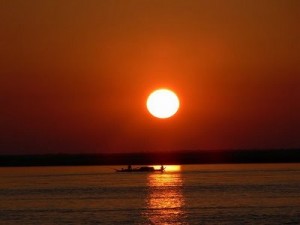
Location
Located at the gateway of Northeast India, Assam is separated by Bangladesh from mainstream India. The state is bounded in the north by Arunachal Pradesh and Bhutan; in the east by Nagaland, Manipur, and Burma; in the south by Bangladesh, Tripura, Mizoram, and Bangladesh; and in the west by West Bengal.
Physical Features
Assam can be broadly divided into three distinct physical units, the Brahmaputra Valley in the north, the Barak Valley in the narrow protruding south, and the state’s hilly region separating the two valleys. The alluvial Brahmaputra Valley, which has highest share of the state’s area, is the result of the erosion and deposition work of the river Brahmaputra and its tributaries. It is a flat region with a slope of only 12 cm every kilometer. The Barak Valley is smaller to the Brahmaputra Valley and a swampy plain with low hills in between. Like the Brahmaputra, the Barak has also created a fertile valley and is given to destructive floods during the rainy seasons. The Sonai and the Dhaleswari are two important tributaries of the Barak. The hilly region of the state works as a separator between the Brahmaputra Valley in the north and the Barak Valley in the south. It consists of highly dissected and rugged terrain in the north and the south with the tributaries of the Brahmaputra, the Kapili, Jamuna, and Dhansiri crisscrossing in between. The altitude of the region varies from 1,000 m to 1,200 m above sea level.
Climate
There are two distinct climates operating in Assam. While the hills enjoy sub-alpine climate, the plains of the state experience tropical climate with high humidity level in the monsoon. Winter touches this state in the end of the month of October and lasts until the end of February. The nights are cold and the mornings are foggy during this time. Summer begins by mid-May with high level of humidity and rainfall. June is the beginning of monsoon. Thunderstorms known as “Bordoichila” is a frequent occurrence during the afternoons. Spring and autumn with moderate temperatures and modest rainfall are the best seasons of Assam.
Flora and Fauna
Out of the total area of Assam, around 21% is under forest cover. The state has a rich biodiversity and has been gifted by nature with varieties of flora and fauna including the world famous one-horned rhino (Rhinoceros unicornis), pigmy hog, royal Bengal tiger, elephant, swamp deer, Gangetic dolphin, wild buffalo, golden langur, hoolock gibbon, stump-tailed macaque, pig-tailed macaque, hispid hare, etc., while the important birds found in the state include greater adjutant stork, white-winged wood duck, Bengal floricans, spot-billed pelican, lesser adjutant stork, king vulture, etc.
Economy:
Assam is rich in mineral wealth. Assam has good reserve of crude oil, natural gas, limestone, coal, dolomite and refractory clay. Tea is a major industry in Assam. Assam contributes 15.6% of World’s tea production and 55% of India’s tea output. Assam is the first state in the country where oil was struck in 1889 at Digboy. Now Assam has 4 oil refineries. There is also a public sector fertilizer factory at Namrup.
Other industries includes sugar, jute, silk, paper, plywood, rice and oil drilling. Important cottage industries are handloom, sericulture, manufacture of cane and bamboo articles, carpentry, smithy and manufacture of brass utensils. Assam is the largest producer in the World of the Golden Coloured ‘Muga’ Silk.
Tourists Attractions:
- Kaziranga National Park (World Heritage Site) is World famous for ‘’One horned Rhino’’.
- Sivasagar is famous for the remains of the Ahom Kingdom and Shiv Temple.
- Majuli is the Biggest River Island in the World with a great treasure of ‘Satriya’ Culture.
- Dibru Saikhua National Park is famous for its Wild horses.
- Manas National Park for rich wildlife and biodiversity.
- Tezpur for scenic beauty and historical remainings.
- Guwahati – the capital city and has various tourist spots.
- Nagaon for ‘Bordua’ the place of ‘Srimanta Sankaradeva’
- Haflong, the scenic hill station.
- and many more…..
Welcome to Assam………….
